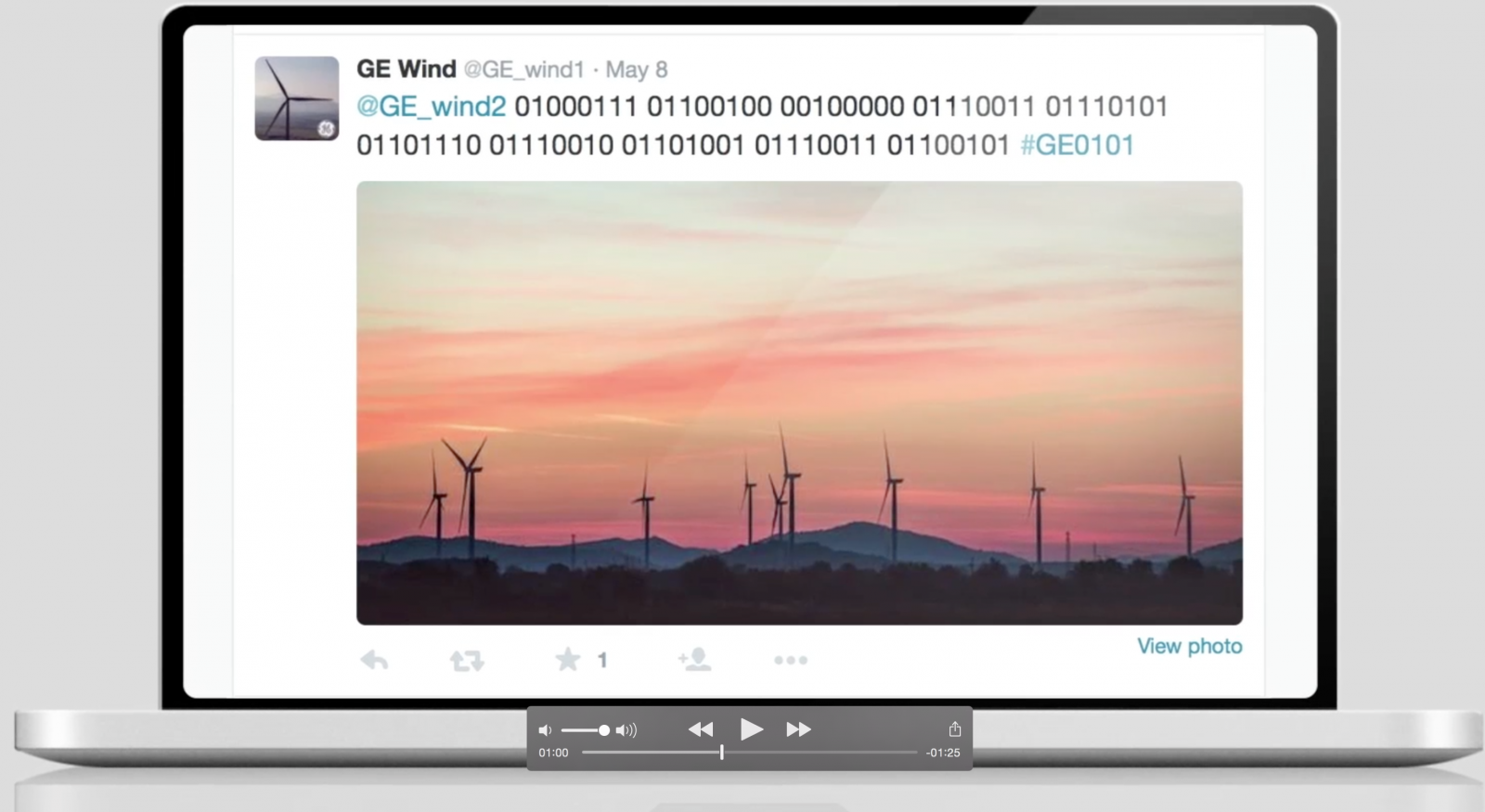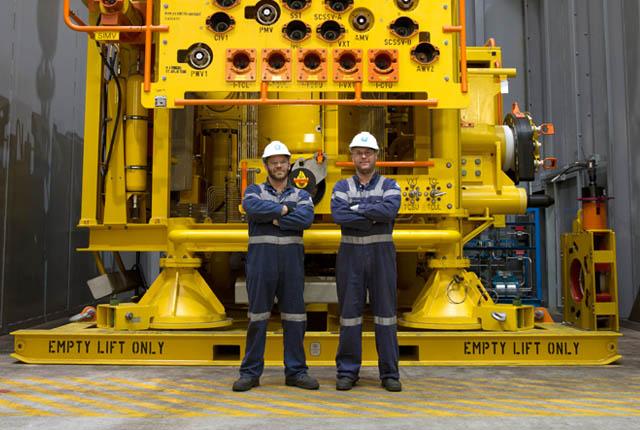As GE takes the next technological leap forward, sensor-enabling its machinery, from streetlights to locomotives, and wirelessly capturing the data that flows from each connection point, coding provides the means not only to sift and analyse the stream, but to net the benefits. Programmers will identify the anomalies that save millions, and code the operational twists that change lives.
In 2015, GE Australia wanted to invite computer programmers into an industrial-strength conscious-raising challenge, and to test the algorithmic agility of Australian software engineers.
The Tweeting Machines Challenge was designed to have visual cryptography at the heart of a many-layered conundrum—this was no 25-words-or-less competition. A trip for two to San Francisco, to the GE Minds and Machines Conference in September 2015 would cause coders’ heads to swivel. And the penultimate resolution of the challenge, an image of a “Christmas Tree”, the machine that controls the output from oil or gas well heads, made the important link: skilled programming minds enable machines.
The broader Tweeting Machines campaign was designed to show the general public that machines can communicate with one another, in binary code, and how the data generated by these communications forms the basis of the Industrial Internet.
GE’s creative team took a light-hearted approach to the deep concept of big data, scripting a tweeted flirtation between a wind turbine and a locomotive; the exchange between one experienced GE jet engine mentoring a newbie to the skies; and other machine-to-machine relationships. In May this year, eight such machine conversations played out on social-media platform, Twitter, in the machines’ native tongue—binary code. Each conversation was accompanied by an image that would become key to the challenge.
At midnight on May 20, 2015, the Challenge tweet went out across GE and software-engineers’ channels: “Calling all Super Coders! Unlock our #EasterEgg and WIN a trip to #SFO #GE0101, more here invent.ge/1ReEQsH.”
On GEreports competitors found a zip file containing the eight machine conversations in binary and in text; the competition terms and conditions; and the eight photos. But these versions of the photos each concealed one-eighth of the “Christmas tree” image. The pixels of the “Christmas tree” had been scattered among the host photos’ own pixels such that the naked eye couldn’t detect anything unusual in these pictures.
 Variable Length Key based Visual Cryptography Scheme for Color Image using Random Number. Given the information within that paper, programmers would realise what to do. But before clue No. 8 was tweeted, Andrew Radion completed the challenge—and won!
Variable Length Key based Visual Cryptography Scheme for Color Image using Random Number. Given the information within that paper, programmers would realise what to do. But before clue No. 8 was tweeted, Andrew Radion completed the challenge—and won!Inside the mind of a coding champion
“I don’t normally go on Twitter,” says civil engineer Andrew Radion. But serendipitously, on a night in May, he was scanning his feed and spotted the promoted GE post.
A dedicated programmer as a boy, Radion now works in the design of water and wastewater infrastructure and in hydraulic modelling of water supply and wastewater networks, applying his coding background to designing spreadsheets and database queries that automate repetitive processes. He also enjoys doing mind-bending puzzles, so the Tweeting Machines Challenge piqued his interest.
“Based on the binary conversions, it seemed like it wouldn’t be that complicated to solve the problem,” says Radion. He checked all the translations of the binary conversations for anomalies, but found them to be straight representations.
On May 23, the first clue of the challenge arrived to ease his binary pain: “A picture tells a thousand words, but not words in this case.” Radion twigged to leave the tweets alone and delve into the pictures.
“I had a chat to my brother Greg, who’s an electrical and computer systems engineer working in the US, and he suggested exploring steganography, a method of hiding data within image files.” Radion plunged down that rabbit hole for a little while, as clues pointing to hidden information kept coming: “The image itself has no significance, it’s what’s inside that counts.”
But because steganography is different to visual cryptography, in that it’s usually used to hide text or other data files in an image, rather than visual information, Radion got little further, except, “I did identify that there was some sort of data hidden in the last two bits of all the colour channels in the picture,” he says.
Clue number six tweeted in: “Visual cryptography is a passion for our machines.” At that point, Radion realised he should be trying to find visual, and not text, information within the images. He found a software package that let him look at the bits that represent each pixel in the photos; he could see that the first six bits of each colour channel of each pixel contained the normal colour data for the image, but that the last two were seemingly random—a difference that wouldn’t change the appearance of the pictures. He surmised that “something was hidden” in those two bits.
Radion deduced that he would have to “perform a mathematical operation, a binary XOR, on the first pixel of every picture” (the top left-hand pixel), to arrive at the first part of the hidden image. The same mathematical operation then had to be performed on every subsequent corresponding pixel in each picture. Before your mind boggles, Radion adds, “That’s where the algorithm comes in.”
He chose a programming language called Visual Basic for his coding. And online he also found the as-yet-unreleased next clue—the paper, Variable Length Key based Visual Cryptography Scheme for Color Image using Random Number.
He tried several coding approaches, and says, “It’s not a very clear picture I got out in the end.” But it was clear enough for him to realise he didn’t know what the depicted machine, the “Christmas tree”, was. Importantly, he could see there was a URL beneath the image: http://011100100110000101101110011001000110111101101101.com.au/ (binary for “random”). At that location, the GE website posed a final question: “How heavy is the machine shown in the decrypted image?”

The puzzler in Radion took over: “Basically, I looked up ‘machine’ as a keyword on GEreports and halfway down the page there was a picture of two guys standing in front of this same yellow machine … I clicked on it and it said it was a Christmas tree.” It was the “Easter egg” referred to in the original challenge tweet. And Radion found the answer to the “heavy” question in the story accompanying the photo..
It was 4.30am on June 4 when our winner submitted the ultimate solution to the challenge: that the Christmas tree weighs 81 tonnes!
“Yeah, I was exhausted,” he says. But, “It felt really good!” Radion estimates that over several researching, thinking, calculating, hair-tearing, coding and re-coding sessions, he spent a total of 100 hours unravelling the challenge.
Just as Radion used an algorithm to do his heavy data crunching, he says the Industrial Internet, is allowing processing of vast amounts of related and seemingly unrelated data “in a way that lets you solve problems or improve performance”. He believes a combination of communicating machines and industrial-strength calculation will help humanity to expose systemic problems in the way we’re doing things, and unlock innovative solutions.
Watch the full interview with GE ANZ CIO Mark Sheppard and Andrew on how Andrew cracked the code





